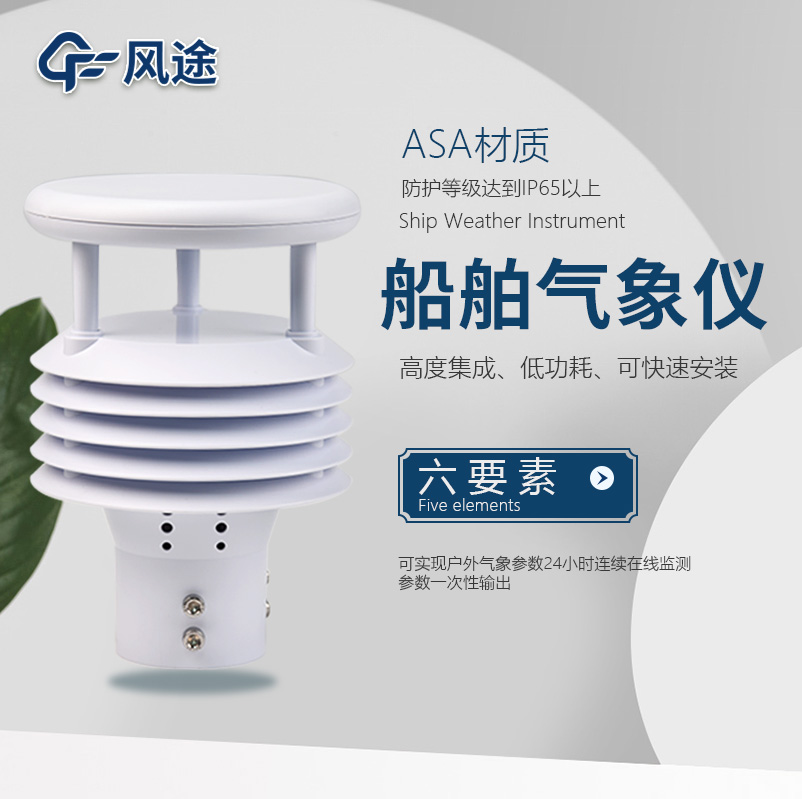Shandong Fengtu IOT Technology Co., Ltd
Sales Manager:Ms. Emily Wang
Cel,Whatsapp,Wechat:+86 15898932201
Email:info@fengtutec.com
Add:No. 155 Optoelectronic Industry Accelerator, Gaoxin District, Weifang, Shandong, China

Sales Manager:Ms. Emily Wang
Cel,Whatsapp,Wechat:+86 15898932201
Email:info@fengtutec.com
Add:No. 155 Optoelectronic Industry Accelerator, Gaoxin District, Weifang, Shandong, China
time:2025-10-24 09:16:44 source:Weather Station viewed:192 time
In the marine navigation field, accurate meteorological monitoring is directly related to navigation safety and efficiency. The FT-Y66 in 1 Weather Sensor launched by Fengtu Technology is a piezoelectric six-element sensor specifically designed for marine environments. Through a highly integrated structure, it real-time monitors core meteorological parameters such as ambient temperature, relative humidity, wind speed, wind direction, atmospheric pressure, and piezoelectric rainfall, providing all-weather data support for ship navigation. Let's take a look at its advantages.
The FT-Y6 uses the principle of continuous ultrasonic frequency conversion to measure wind speed and direction. By analyzing signal phase changes rather than relying on high-precision timers, it effectively avoids measurement errors caused by startup delays, temperature fluctuations, or circuit demodulation delays in traditional sensors.
The probe is designed with a hidden top cover structure, which not only prevents interference from rain and snow accumulation but also avoids natural wind obstruction, ensuring the continuity of data collection.
The device integrates six meteorological parameters into one, supports RS485 communication interface (compatible with MODBUS protocol), and can be optionally equipped with USB, Ethernet, or wireless transmission modules to achieve remote real-time data transmission with a minimum interval of 1 minute.
The above integrated design greatly reduces installation complexity, avoids wear caused by moving parts, and achieves a convenient user experience with maintenance-free operation and no on-site calibration required.
To adapt to harsh marine environments, the FT-Y6 uses an ASA engineering plastic housing with corrosion resistance, UV protection, and weathering resistance properties, ensuring it does not easily discolor during long-term outdoor use.
It is equipped with a watchdog circuit and automatic reset function internally, enabling stable operation even in complex electromagnetic environments.
The measurement accuracy has been calibrated: wind speed error ±0.1m/s, wind direction error ±2°, temperature error ±0.3℃, rainfall error ±4%, capable of responding to rapid changes in marine weather.
Currently, this device has been widely applied in scenarios such as ocean-going vessels, drilling platforms, and port terminals, serving as a tool to enhance navigation safety and operational efficiency.

Recommend a Handheld visibility detector, model FT-SN10.It has several highlights.Firstly, it adopts a special testing method. It sucks air into a closed sampling chamber, which can not only ensure real-time exchange with the outside air but also enable normal measurement in a narrow room.Secondly,...
Adverse weather conditions pose a significant threat to the safe operation of expressways. Severe meteorological phenomena such as waterlogged road surfaces, blizzards with icing, dense fog and patchy fog, and sandstorms not only reduce atmospheric visibility but also alter road conditions. Statisti...
In canal shipping, visibility is a key factor affecting the safety of ship navigation. Weather conditions such as fog, haze, rain, and snow can reduce visibility on canals, making it difficult for ship drivers to clearly identify waterways, navigation marks, and other ships, increasing the risk of a...
The Visibility Detector is mainly a forward-scattering visibility meter, which is an important instrument for measuring visibility.The transmitter and the receiver are kept at a certain distance and at a certain angle. The receiver only receives the forward-scattering light of the atmosphere. The tr...